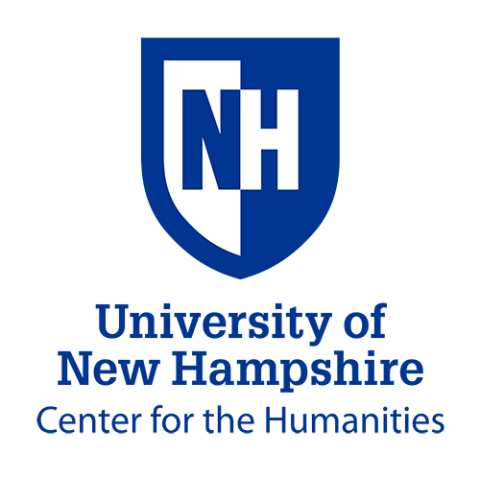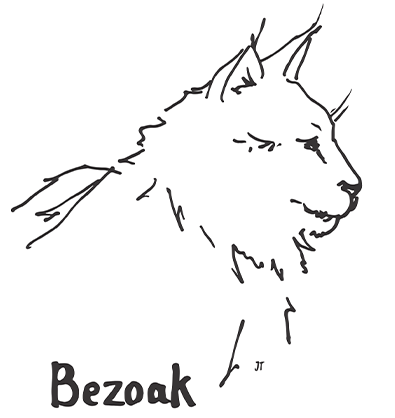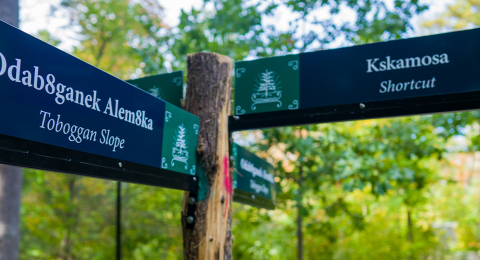The area we know today as Seacoast New Hampshire is the traditional ancestral homeland of the Abenaki, Pennacook and Wabanaki Peoples past and present. Yet, there has historically been little acknowledgment of Indigenous peoples, despite the various ways the campus recognizes other peoples.
The Indigenous NH Collaborative Collective has worked with the Cowasuck Band of the Pennacook-Abenaki People to identify and name trails and bridges throughout the College Brook Ravine (the area behind Hamilton Smith and Dimond Library). The College Brook Ravine has significant landscape features that are important to the Abenaki people, past and present, such as the College Brook, the surrounding wetlands (medicine gardens), and trees. This area is a well-traveled, busy part of campus that previously lacked identification of the various trails, bridges, and shortcuts throughout the space.
In order to identify unique characteristics of the landscape, members of INHCC explored the area as a group, taking photographs and notes about each trail and bridge. Key descriptive words that stood out were translated into the Abenaki language. For example, the long, downhill slope that leads from the Dimond Library down to the southeast, is reminiscent of a sledding hill. The word toboggan has its linguistic origins in the Abenaki word for sled, so we selected Od8b8ganek Aalem8ka, or “Toboggan Slope” for this path. Some names were also chosen based on our observations of their use: for a trail that cuts directly across the ravine, we selected Kskanosa, meaning “It is a shortcut” for this path. Although these Abenaki descriptions are new names for these modern trails, the trail and bridge names exemplify the historical importance of Abenaki place names.

1. Cowasuck Band
Since the early 1990s, the Cowasuck Band of the Pennacook-Abenaki People has been engaged in preserving existing and decolonizing anglicized names that have been applied to Abenaki-Pennacook places, mountains, rivers, lakes, and other geographic features. As founding members of the Indigenous NH Collaborative Collective, Denise and Paul Pouliot, head speakers of the Cowasuck Band have also led the work at UNH to name the trails, walkways, bridges, stairs, and other campus landscape and infrastructure with Abenaki names. You will see the logo or flag of the Cowasuck Band on the trail markers throughout the College Brook Ravine.

2. INHCC
In the fall of 2019 members of the Indigenous NH Collaborative Collective, a grassroots group including UNH staff, faculty, graduate and undergraduate students, initiated a project to bring recognition to the Indigenous heritage of the UNH landscape. INHCC members worked with Abenaki leaders to develop this project and in addition to developing a successful relationship with the University Architect and Director of Campus Stewardship, INHCC sought and received the support of numerous University representatives, including the Native American and Indigenous Studies Minor, the Dean of the College of Liberal Arts, the Dean of the College of Life Sciences and Agriculture, the Undergraduate and the Graduate Student Body Senates, and the Office of Community, Equity, and Diversity.

3. Center for the Humanities
In 2022 the UNH Center for the Humanities received a Sustaining Public Engagement Grant from the American Council for Learned Societies (ACLS) for a project titled “BIPOC Monumentality in New Hampshire,” which seeks to move forward ongoing work by INHCC and the Black Heritage Trail of NH (BHTNH). The focus is on supporting those organizations’ efforts to make visible the history and cultural presence of Indigenous and Black communities by establishing more inclusive markers and monuments and enhancing digital resources. It is also intended to spark research and conversation on land connections and the future of monuments. The Center has allocated part of the award from ACLS to support the College Brook Ravine Abenaki Trails project, recognizing that installing this signage is a key step in bringing to the campus community a fuller understanding and appreciation of the space they traverse each day.
ABENAKI LANGUAGE INFORMATION
These trails and bridges have been assigned a descriptive name in the Abenaki language. Abenaki is part of the Algonquin language family, spoken by Indigenous peoples along much of the east coast of North America before Euro-American arrivals and government efforts to suppress Indigenous language and culture. Today Abenaki is an endangered language, but Abenaki tribal members are working to revitalize the language. Revitalizing a language can help to preserve important and unique aspects of Indigenous cultures. For example, in the Abenaki language (as in other Indigenous languages), there is no grammatical gender. Instead of using “he” or “she,” the Abenaki language uses a common third person singular pronoun for people of any genders: “agema.” Abenaki does, however, differentiate between animate and inanimate nouns, using specific word forms for living things, including plant people and animal people.
Tips on pronunciation: the use of 8 stands in for the French ô and represents a nasal “ohn” sound. Words ending in gw should end with an unvoiced “wha” sound. B and P sounds are often interchangeable. The letter G is always a hard G, as in Google. For more language lessons, visit the Cowasuck Band of the Pennacook-Abenaki People page.
Visitors to the College Brook Ravine can listen to audio recordings to learn how to pronounce the Abenaki words, but are also welcome to use the English translations.
TRAILS
Gweni Wsk8wdik
(Long Trail)
This is the longest path through the College Brook Ravine, running roughly west to east from Spaulding Hall to the Memorial Union Building. This trail crosses College Brook at the Oskananhlagw (Bone Metal) bridge. Abenaki peoples have created and maintained many trails throughout the region we know today as New Hampshire. One of the longest Abenaki Trails still known today is the Kwan-i-teo-ok (or Connecticut) Trail, extending throughout New Hampshire along the Connecticut River for over 250 miles!
Kskamosa
(Shortcut)
This is a path running northeast-southwest from the Memorial Union Building past Horton Hall. Kskamosa crosses College Brook at the Abaziiya 8wdisizek (Wooden Path) bridge. When traveling through the College Brook Ravine, this trail provides a shortcut to the south side of campus.
Ksakameniganek
(Short Portage)
This trail runs from north to south along the east side of the Dimond Library, beginning next to Toboggan Slope and running toward the Paul Creative Arts Center. This direct route incorporates stairs as well as the Seniga Bedegw8gihla (Stone Arch) bridge. A portage is typically a path used by people to carry a canoe between two bodies of water, but can refer to carrying any objects along a route!
Odab8ganek Alem8ka
(Toboggan Slope)
This trail runs northwest-southeast across the College Brook Ravine area. The northwestern point begins behind Thompson Hall and next to the Dimond Library, and runs downslope through the ravine, crossing College Brook at the Nanamebaga (Rippling Water) bridge. Campus tradition describes this path as a seasonal sledding hill. In the Abenaki language, Odab8ganek means toboggan, or sled. The origin of the word toboggan comes from variations across Algonquian languages spoken by Indigenous peoples of the Northeast.
BRIDGES
Oskananhlagw
(Bone Metal)
This bridge crosses College Brook on the Gweni Wsk8wdik (Long Trail) close to an entrance to Spaulding Hall. In the Abenaki language, the same word is used for bone and metal. When metal objects made of steel were introduced in the colonial era, Indigenous people needed to adopt a word for the material, and borrowed the word for bone, one of the strongest materials in the natural world.
Abaziiya 8wdisizek
(Wood Walkway)
This passage across the brook on the Kskamosa (Shortcut) trail leads to the south side of the Memorial Union Building. Wood is a particularly important material in Abenaki culture. The Abenaki origin story describes how the ancestors were created from ash trees, an important tree in riverside areas.

ACKNOWLEDGEMENTS
Funding and support for this project was provided by the American Council for Learned Societies; the UNH Office of Community, Equity, and Diversity; the UNH President’s Fund; the UNH Provost’s Fund; the UNH Office of Stewardship; and a donation from the Coe-Hall Memorial Fund.
